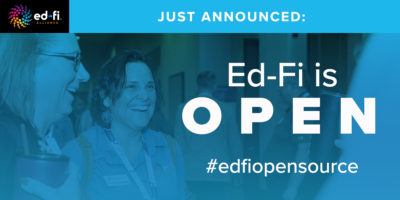It feels odd to talk about data systems in these challenging times. Yet, many of us are searching for up-to-date information from multiple data sources about the effects of COVID-19 on our university and school closures, as well as the impact of online learning on our students and teachers. Some states have already waived some of the standard requirements for teacher certification because assessments and in-person field experiences have ceased while schools and businesses are closed.
The availability of and easy access to data from multiple sources will become even more valuable in the months and years ahead as we evaluate the impact of all these changes on students, teachers, schools, and preparation programs. Data interoperability is critical for schools and education agencies so you can benefit from the data systems you work hard to populate and maintain. The real power of interoperability lies in the wealth of readily available information that gets unlocked when your data systems are connected and well managed.
And this is why we collect so much data–not merely for compliance, but because we want actionable information. We want to understand trends and relationships between projects, programs, and the people who are providing and receiving educational services. We want to be able to figure out what to do differently in the future to improve student outcomes.
“Gone are the days of making decisions based on gut feelings or disparate data. With the full implementation of the Teacher Preparation Data Model, Ed-Fi is enabling both US PREP and its coalition of universities to more efficiently move, make meaning of, and evolve our approaches with data to better serve teachers, students, and communities.”
Calvin J. Stocker, Senior Director of Operations and Strategic Initiatives, US PREP National Center
The Goal of Ed-Fi for Educator Preparation Programs
Educator prep programs, as well as state and local education agencies, have expressed strong interest in better understanding what makes effective teachers and leaders, and how best to track applicants, effectiveness, and retention in pre-service and in-service sectors. Our Teacher Prep Data Model is the key to unlocking answers! Enabling data interoperability through a robust technology roadmap is a valuable way to turn mounds of data into actionable information that drives continuous improvement.
Ultimately, every educator preparation program (EPP) preparing teachers, principals, and/or superintendents should be able to create an interoperable data system, one that connects:
- Student information systems
- Assessments
- Clinical observations
- Faculty, staff and student perception surveys
By connecting all of this information using the Ed-Fi Data Standard, EPP administrators and faculty can more easily use your data sources to inform continuous improvement efforts and prepare quality teachers and leaders.
“We have been working for four years to develop a culture of inquiry among our faculty. We want our faculty to ask important questions about their practice, our student performance, and how to achieve quality and positionality for our program. Data is essential to answer those questions.”
We need to be smart and efficient when planning for systemwide interoperability and data visualizations. You know the old adage, “How do you eat an elephant? One bite at a time.” The Ed-Fi Alliance has learned from both K-12 and EPP implementations that biting off too much at first— trying to pull in a large set of data sources at once—takes a lot of time and resources. The one-massive-bite approach is far less likely to succeed due to the sheer scope of the effort, and can leave teams feeling overwhelmed and discouraged.
We are working with organizations to eat the elephant one bite at a time by focusing on addressing one or two issues rather than integrating all data sources in one project.
How to Narrow Your Scope
The Ed-Fi Alliance conducted a series of stakeholder engagement interviews with EPPs and state and local education agencies in Fall 2019 to better understand the pressing information needs of educator preparation programs. A few common high-priority areas were raised by almost every stakeholder. The two most referenced areas where EPPs crave accessible, easy-to-understand data are:
- Candidate Clinical Experience and Performance: Are prospective teachers or aspiring principals improving throughout their clinical practice? Are there areas of weakness in teaching/leadership practice?
- Program Diversity and Persistence: Can we study the persistence patterns of students from program application to enrollment and through graduation? Is there diversity of program applicants, candidates and program graduates? Are candidates of color enrolling and persisting through graduation?
Concentrating an initial Ed-Fi implementation on either of these use cases will help an EPP plan a tightly focused, straightforward project that serves as a strong foundation for expanded interoperability efforts down the line. These areas should also allow you to utilize existing data sources within your program to support a faster, better, more affordable initial Ed-Fi implementation.
Is Now the Right Time? Ed-Fi Readiness Indicators
There are key indicators that highlight which EPPs are primed for a successful Ed-Fi implementation. Based on lessons learned from previous implementations, key readiness indicators include, but are not limited to:
- Leadership and Staffing: Engaged and supportive leadership; skilled project manager, technical and data management staff; collaboration; active engagement from Central IT
- Governance and Decision-Making: Executive team oversight; broad engagement from programs; strong governance and decision-making processes
- Technical Approach: Clear technology roadmap with stable requirements and realistic baseline; clear technical processes and procedures
- Sustainability and Knowledge Transfer Plans: Short- and long-term human capital and resource planning; technical feasibility and operational viability; formal documentation and training; opportunity to share and reuse material and systems
If you’re ready to explore our Teacher Prep Data Model and the impact it can have for your program, contact us! We can help you build your implementation plan and will gladly connect you with other programs that are successfully using the educator extensions.
Who to Contact:
Nancy Smith, TPDM Community Manager, [email protected]
Steven Arnold, TPDM Development Lead, [email protected]



